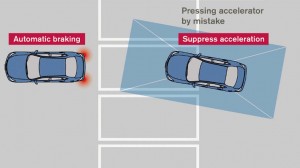
Nissan's system can help prevent pedal misapplication in a parking lot by spotting potential obstacles.
There’ve been a lot of headlines written about so-called “Unintended Acceleration” in recent years. And there’s little doubt that there have been some legitimate problems leading to runaway cars, including the jammed carpets and sticky throttles that led Toyota to recall millions of vehicles since 2009.
But one thing that safety investigators have also seen, over and over, is the likelihood that a significant number of supposed runaway car incidents are actually caused by driver error, most often when a motorist reaches for the brake but punches the throttle, instead.
A new system being introduced by Nissan could help reduce the likelihood of such situations – especially in parking lots or garages where there is little time to recover from a pedal misapplication.
The technology goes by the ungainly Emergency Assist for Pedal Misapplication with Carpark Detection Function, a name that doesn’t even lend itself to an elegant acronym – unless Nissan has found one in Japanese. But the name doesn’t matter if the new system works.
Call it EAPM, for short, it relies on the same camera set-up used by the Around View monitoring system now offered on a variety of Nissan and Infiniti models. Nissan, you may recall, has been betting on vision systems, rather than more costly radar technologies, using the basic back-up camera on the new Altima to integrate features that include Cross-Traffic Alert and Blind Spot Detection.
In this case, the vehicle’s cameras – along with a near-range ultrasonic sonar system — are constantly looking out for nearby cars, walls or pedestrians. And if it detects an obstacle, EAPM will automatically limit the vehicle’s acceleration even if you slam the pedal to the metal. If necessary, it will also apply the brakes.
The new system is expected to make its debut on the updated Japanese version of the Nissan Elgrand minivan but considering the way the maker has rolled out other safety systems in recent years it would be a surprise if EAPM didn’t migrate to other products – in other markets – over the next several years should it prove effective.
The pedal misapplication system is part of Nissan’s broader “Safety Shield” technology which is intended to use advanced electronics to sharply reduce the number of accidents, injuries and fatalities occurring in the maker’s products.
Of course, Nissan isn’t alone. Volvo has set a goal of zero fatalities in its products and most makers are now adopting all manner of electronic sensors and controls designed to keep human drivers in check. Meanwhile, Silicon Valley tech giant Google’s driverless car program is moving rapidly ahead, company officials contending a production version could be marketable within the next five years.
